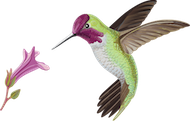Study: to investigate how birds perceive their colorful world by using a field system for exploring bird color vision in a natural setting.
“Most detailed perceptual experiments on birds are performed in the lab, but we risk missing the bigger picture of how birds really use color vision in their daily lives,” Stoddard said. “Hummingbirds are perfect for studying color vision in the wild. These sugar fiends have evolved to respond to flower colors that advertise a nectar reward, so they can learn color associations rapidly and with little training.”
The experiments revealed that hummingbirds can see a variety of nonspectral colors, including purple, ultraviolet+green, ultraviolet+red and ultraviolet+yellow. For example, hummingbirds readily distinguished ultraviolet+green from pure ultraviolet or pure green, and they discriminated between two different mixtures of ultraviolet+red light — one redder, one less so. See published paper here.
The majority of their research is been performed during the summer months at the Rocky Mountain Biological Laboratory in Gothic, Colorado. They conducted exploratory experiments during the spring here in the garden.


